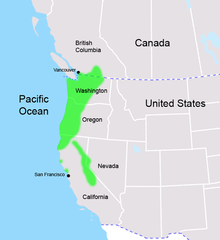Mountain beaver
| Mountain beaver Temporal range: Late Pleistocene–Recent |
|
|---|---|
 |
|
| Scientific classification | |
| Kingdom: | Animalia |
| Phylum: | Chordata |
| Class: | Mammalia |
| Order: | Rodentia |
| Family: | Aplodontiidae |
| Genus: |
Aplodontia Richardson, 1929 |
| Species: | A. rufa |
| Binomial name | |
|
Aplodontia rufa (Rafinesque, 1817) |
|
 |
|
The mountain beaver (Aplodontia rufa) is a North American rodent. It has several common names, including: aplodontia, mountain boomer, ground bear, and giant mole. The name sewellel beaver comes from sewellel or suwellel, the Chinookan term for a cloak made from its pelts. This species is the only living member of its genus, Aplodontia, and family, Aplodontiidae. It should not be confused with true North American and Eurasian beavers, to which it is not closely related.
Mountain beavers are brown, but their fur can range from slightly more reddish to more blackish depending on subspecies, with a light patch under each ear. The animals have distinctively short tails. Adults weigh about 500–900 g (18–32 oz), with a few specimens topping 1,000 g (35 oz). Total length is about 30–50 cm (12–20 in), with a tail length of 1–4 cm (0.39–1.57 in).
The skull is protrogomorphous; it has no specialized attachments for the masseter muscles as seen in other rodents. It is flattened and lacks a postorbital process. The baculum is thin and distinctly forked. The penis is about 4.5 cm (1.8 in) in length. The male does not have a true scrotum, but the testes move into a position called semiscrotal during the breeding season.
Mountain beavers have an unusual projection on each molar and premolar tooth, which is unique among mammals and allows for easy identification of teeth. This projection points toward the cheek on the upper tooth row, but points toward the tongue on the lower. The cheek teeth lack the complex folds of other rodents and instead consist of single basins. They are hypsodont and ever-growing. Two upper and one lower premolars are present, along with all the molars, giving a dental formula of 1.0.2.31.0.1.3
...
Wikipedia

